Chinese Name:红河县哈尼梯田大全
English Name:Rice Terraces in Honghe County, Honghe
Keywords: Hani Rice Terraces
Location: In the south of Ailao Mountain of Honghe Prefecture
Admission Fee: ¥
Opening Hours: All Day Long
Chinese Name:红河绿春县哈尼梯田
English Name:Rice Terraces in Lvchun County, Honghe
Keywords: Hani Rice Terraces
Location: In the south of Ailao Mountain of Honghe Prefecture
Admission Fee: ¥
Opening Hours: All Day Long
Chinese Name:红河金平县哈尼梯田
English Name:Hani Rice Terraces in Jinping County, Honghe
Keywords: Hani Rice Terraces
Location: In the south of Ailao Mountain of Honghe Prefecture
Admission Fee: ¥
Opening Hours: All Day Long
Overview
Jinping County (金平县), located in Honghe Hani and Yi Autonomous Prefecture (红河哈尼族彝族自治州), is home to over 80,000 Hani people (哈尼族), making up about 25.6% of the county’s population. Through generations of agricultural labor, the Hani people have created a unique cultural tradition centered around rice terraces. The terraced fields in Jinping span approximately 163,382 acres, with their origins dating back to the Song Dynasty (宋代). These terraces are distributed across 13 townships in the county, featuring various types such as horizontal terraces, sloped terraces, and reversed sloped terraces.
Major Terraced Areas
1. Jinhe Town (金河镇)
- Hani Fields—Malutang (哈尼田—马鹿塘)
2. Jinshuihe Town (金水河镇)
- Pujiao (普角)
3. Mengla Township (勐拉乡)
- Wengdang—Zhemi Sankeshu (翁当—者米三棵树)
4. Tongchang Township (铜厂乡)
- Dongzong River (董棕河)
5. Shayi Township (沙依坡乡)
- Ahami—Adubo (阿哈迷—阿都波)
6. Adebai Township (阿得博乡)
- Shuiyuan (水源)
7. Ma’an Bottom Township (马鞍底乡)
- Puma—Maguaitang (普玛—马拐塘)
These terraced areas cover about 35,000 acres and are known for their aesthetic value.
Cultural Significance
The traditional farming methods and the visible rice straw stacks in the butterfly valley (蝴蝶谷) area create a stunning landscape. Walking along the stone-paved mountain paths while admiring the terraces evokes a sense of admiration for the hard work and wisdom of the various ethnic groups, as well as the gifts nature provides. The terraces, built along the mountainsides, curve gracefully, connecting seamlessly in a beautiful display of craftsmanship. Each section of terrace resembles a musical note, together composing a melodious rural symphony.
The expansive terraced fields of Jinping County are closely linked to the rice terraces of Yuanyang (元阳) and Luxi (绿春), forming an integral part of the Hani rice terrace culture along the southern bank of the Honghe River (红河).
Agricultural Highlights
As of 2022, the rice sowing area in Jinping County reached 164,000 acres, with 35,000 acres dedicated to red rice terraces. The estimated yield for this red rice is around 14,000 tons, with a total output value of approximately 210 million yuan.
Specific Terraced Areas
- Butterfly Valley Terraces (马鞍底蝴蝶谷梯田)
- Adebai Township Terraces (阿得博乡梯田)
- Baihe Village in Jinhe Town Terraces (金河镇白马河村梯田)
- Terraces in Jinhe Town (金河镇梯田)
- Kunyimi Terraces in Adebai Township (阿得博乡昆一迷梯田)
- Shuiyuan Village Terraces in Adebai Township (阿得博水源村梯田)
How to Get There
Jinping County is accessible by:
- Car: Drive from the nearest major city, Gejiu (个旧) or Kunming (昆明), which provides a scenic route.
- Bus: Regular buses operate from major cities to Jinping, making it convenient for travelers.
Travel Tips
- Best Time to Visit: Autumn is ideal for witnessing the rice harvest, typically from late September to early November.
- Respect Local Culture: Be mindful of Hani traditions and practices while visiting.
- Photography: Capture the beauty of the terraces, but ensure you ask for permission before photographing locals.
- Stay Hydrated: The region can be hot during the day; carry water while exploring.
Chinese Name:丽江茶马古道:白沙古镇-玉水寨-玉龙水库-文海
English Name: The Ancient Tea Horse Road from Baisha Ancient Town to Wenhai Lake(Baisha Ancient Town-Yushuizhai-Yulong Reservior-Wenhai Lake)
The Ancient Tea Horse Road, a historic trade route connecting China with Tibet and beyond, features several notable segments between Baisha Ancient Town and Wenhai Lake. Here’s a detailed guide to this fascinating route:
Segment Overview
- Baisha Ancient Town (白沙古镇)
- Location: In Lijiang, Yunnan Province
- Highlights: Baisha Ancient Town is renowned for its well-preserved traditional Naxi architecture and rich cultural heritage. It is an excellent starting point for exploring the Ancient Tea Horse Road, offering insights into the history and culture of the Naxi people.
- Yushuizhai (玉水寨)
- Location: A village near the Yulong Snow Mountain, accessible from Baisha
- Highlights: Yushuizhai, also known as Jade Water Village, is known for its picturesque scenery and traditional Naxi culture. The village is surrounded by lush landscapes and offers a glimpse into the lifestyle of the local people.
- Yulong Reservoir (玉龙水库)
- Location: Located at the base of Yulong Snow Mountain
- Highlights: The reservoir is an essential part of the region’s water management system and provides stunning views of the surrounding mountains. It’s a peaceful spot for sightseeing and appreciating the natural beauty of the area.
- Wenhai Lake (文海)
- Location: Situated near the Yulong Snow Mountain
- Highlights: Wenhai Lake is known for its serene environment and clear waters. It’s a popular destination for hiking and nature lovers, offering beautiful views of the surrounding landscape and the opportunity to explore the diverse flora and fauna.
Travel Route
- Baisha Ancient Town to Yushuizhai:
- Distance: Approximately 15-20 kilometers
- Travel Time: Around 30-40 minutes by car
- Description: This segment takes you through scenic countryside and traditional Naxi villages, offering a glimpse into the local culture and lifestyle.
- Yushuizhai to Yulong Reservoir:
- Distance: Approximately 20-25 kilometers
- Travel Time: About 40-50 minutes by car
- Description: The route to the reservoir passes through beautiful mountainous terrain and offers panoramic views of the surrounding landscapes.
- Yulong Reservoir to Wenhai Lake:
- Distance: Approximately 15-20 kilometers
- Travel Time: Around 30-40 minutes by car
- Description: This final segment leads to Wenhai Lake, with opportunities for hiking and exploring the natural beauty of the area.
Highlights and Activities
- Cultural Exploration: Experience the unique culture of the Naxi people in Baisha and Yushuizhai.
- Scenic Views: Enjoy stunning landscapes and panoramic views of Yulong Snow Mountain, the reservoir, and Wenhai Lake.
- Outdoor Activities: Hiking, sightseeing, and photography opportunities abound along the route.
Travel Tips
- Best Time to Visit: Spring and autumn are ideal for pleasant weather and clear skies.
- Transportation: Renting a car or hiring a local guide is recommended for convenience and to fully enjoy the scenic route.
- Accommodation: Consider staying in Baisha Ancient Town or nearby areas for easy access to the starting point of the route.
This journey along the Ancient Tea Horse Road offers a rich blend of cultural heritage and natural beauty, providing a memorable experience for travelers.
Lijiang Basin
Millions of years ago, a tremendous geological force pushed the Indian Plate northward, colliding with the Eurasian Plate. The two plates, being of comparable density, resulted in a massive crumpling of the Earth’s surface. After millions of years of uplift and evolution, these folds gave rise to the Tibetan Plateau and the Yunnan-Guizhou Plateau.
Yunnan is precisely located at the point where these two plates meet.
From the northern peak of Mount Kawagebo (卡瓦格博峰), standing at 6,740 meters, to the southern end at Hekou County (河口县), which is only 76.4 meters above sea level, the linear distance is a mere 960 kilometers, with an elevation drop of 6,663.6 meters. This makes Yunnan a giant staircase, high in the north and low in the south. At the northwestern end of this staircase, the Nu River (怒江), Lancang River (澜沧江), and Jinsha River (金沙江) flow downward, creating the famous Three Parallel Rivers (三江并流) region.
Three Parallel Rivers
The Nu River and Lancang River traverse Yunnan, flowing into Myanmar. The Jinsha River, obstructed by mountains, makes a sharp 150-degree turn at Shigu Town (石鼓镇), forming the renowned First Bend of the Yangtze River (万里长江第一湾). Subsequently, heading north, the Jinsha River carves the world-famous Tiger Leaping Gorge (虎跳峡) between the Yulong Snow Mountain (玉龙雪山) and Haba Snow Mountain (哈巴雪山). The river surges from the gorge, only to be blocked by Yulong Snow Mountain, which causes it to turn southward, embracing the Yulong Mountain Range (玉龙山脉).
This north-south shift creates a vast river bay area, providing the land with distinct spatial independence. Because the Jinsha River was historically known as Lishui (丽水), this area came to be called “Lijiang Basin” (丽江坝子).
Lijiang Basin
Note: Nowadays, when people refer to Lijiang, they mostly mean the Mu Mansion (木府) built by the Mu family during the Ming Dynasty, along with the surrounding residential small town. Strictly speaking, this small town should be called “Daiyan Ancient Town” (大研古城), while Lijiang refers to the basin area nestled between the Jinsha River and Yulong Snow Mountain, also known as “Lijiang Basin.”
The Naxi People and Baisha
It is said that during the Warring States period, the Qiang ethnic group, located in northwestern China, migrated southward to avoid war, eventually settling in the upper reaches of the Min River and then the Yabi River basin, finally stopping south of Yulong Snow Mountain. From then on, this group, distributed at the intersection of Sichuan and Yunnan, came to be known as the Mosuo or Naxi (纳西人), with their dwelling place called Baisha (白沙).
Lijiang Tourist Map
Baisha, backed by Yulong Snow Mountain, features flat terrain and abundant water sources, providing favorable conditions for agriculture and animal husbandry for the Naxi people. From a military perspective, the mountain’s edge also served as a strategic retreat point. The Naxi people’s decision to settle here reflects early human reverence for and dependence on nature.
Before the Song Dynasty, the scattered Naxi groups in Baisha existed in a state of “independent chieftaincy” with no central governance. Among these groups, a few relatively powerful tribes emerged, one of which was reportedly the ancestor of the Mu family—the Yegunian Tribe (叶古年部).
In 1252 AD, Kublai Khan passed through Lijiang on his way to conquer Dali, targeting the Southern Song Dynasty. Many Naxi people in the Sichuan-Yunnan region chose to resist the Yuan army, but the Naxi tribe led by the Yegunian family opted to submit and assist the Yuan forces in attacking Dali.
History shows that this decision determined the fate of the family for the following centuries.
In 1253 AD, Emperor Möngke of the Yuan Dynasty established the “Chahanzhang Guanmin Official” in Luobo City (罗波城, present-day Shigu Town), appointing the leader of the Yegunian family to this position. After the short-lived Yuan Dynasty fell, the Hongwu Emperor Zhu Yuanzhang took over Central China.
Tubo and Nanzhao
At that time, the Nanzhao Kingdom no longer existed, but Tubo (吐蕃) still posed a threat to the empire. The disorganized Ming government urgently needed a force to contain Tubo. The Yegunian tribe, located at the junction of the Yunnan-Guizhou Plateau and the Tibetan Plateau, naturally came into Zhu Yuanzhang’s view.
Thus, Zhu Yuanzhang removed the horizontal and diagonal strokes from his surname “Zhu” and granted the surname “Mu” to the then leader of the Yegunian tribe, A Jia Ade (阿甲阿得), as a sign of legitimacy. In 1383, A Jia Ade changed his name to Mu De and went to Nanjing to pay homage to the emperor, being appointed as the governor of Lijiang. In 1385, Mu De was further honored with the hereditary title of local chieftain for his military achievements.
From then on, the Mu family officially entered the political map of the Central Government, becoming an inseparable part of the Chinese nation.
With their new identity, the Mu family, influenced by Central Plains culture, gradually developed a sense of political consciousness. This consciousness manifested in their actions, notably through grand construction projects to build lavish mansions, establishing centralized authority and showcasing their identity as regional rulers.
They sought to break away from the old Baisha and create a new world.
Dayan
The Mu family turned their attention to Dayan (大研), located 15 kilometers south of Baisha.
Here, Lion Mountain (狮子山) lies to the west, and Black Dragon Pool (黑龙潭) is to the north, providing favorable conditions for establishing a political capital.
Spatial Distribution in Lijiang
In terms of construction methods, the Mu family modeled their designs after the relationship between the Forbidden City and Shijingshan, placing the Mu Mansion under Lion Mountain. They utilized the natural mountain terrain to mark their presence and create a central point. Thus, the Mu Mansion became the “Forbidden City” (紫禁城) of Lijiang Basin, enduring through 22 generations for 470 years.
After the Mu Mansion was completed, the Naxi people’s living space expanded southward, but Baisha was not completely abandoned. Under new historical conditions, due to its numerous religious facilities and long-standing cultural ties, Baisha gradually took on the role of a religious and cultural center.
From then on, a clear spatial axis was formed from Yulong Snow Mountain to connect Baisha and Dayan, supporting the Lijiang Basin on the Yunnan Plateau.
Overview
Baisha Bazi (白沙坝子) is a picturesque village located in Lijiang, Yunnan Province (云南省丽江市). It is known for its rich cultural heritage, traditional Naxi architecture, and stunning natural landscapes. The village is situated at the foot of the Yulong Snow Mountain (玉龙雪山) and is famous for its beautiful terraced fields, vibrant flowers, and the charming ambiance that attracts visitors seeking an authentic cultural experience.
Attractions
1. Traditional Naxi Culture
Baisha Bazi is home to the Naxi ethnic group (纳西族), known for their unique culture, language, and traditional practices. Visitors can explore the local customs, handicrafts, and folklore that embody the essence of Naxi heritage.
2. Baisha Murals
The village is famous for its ancient murals (白沙壁画), which reflect the influence of Tibetan Buddhism and Naxi culture. These murals can be found in various temples and local homes, showcasing intricate designs and vibrant colors.
3. Yulong Snow Mountain
The stunning backdrop of Yulong Snow Mountain offers opportunities for hiking and photography. Visitors can enjoy breathtaking views of the snow-capped peaks and the lush valleys below.
4. Baisha Village Market
The local market is a vibrant place where visitors can experience daily life in Baisha. Here, you can find fresh produce, local handicrafts, and traditional foods, providing a glimpse into the local culture.
How to Get There
Baisha Bazi is approximately 10 kilometers from Lijiang’s Old Town. You can reach the village by:
- Taxi: A quick and convenient option.
- Bus: Local buses run regularly from Lijiang to Baisha, making it an affordable choice.
- Bicycle: For the adventurous, renting a bicycle offers a scenic ride to the village.
Travel Tips
- Best Time to Visit: The ideal time to explore Baisha Bazi is during spring and autumn when the weather is pleasant, and the landscape is particularly beautiful.
- Respect Local Customs: Be mindful of Naxi cultural practices and traditions while visiting.
- Photography: Capture the stunning scenery and unique architecture, but ask for permission before photographing local residents.
- Stay Hydrated: The altitude can be challenging for some; ensure you drink plenty of water during your visit.
Overview
Kunming Haigeng Hall (昆明海埂会堂) is a prestigious venue under the management of the Yunnan Haigeng Conference Center Management Bureau. Situated in the scenic area of Dianchi (滇池), it faces the stunning Western Hills (西山) and the serene Caohai Lake (草海). Spanning over 70,000 square meters, it is not only a large conference center for the Yunnan Provincial Government but also one of the largest international conference centers in Southeast Asia.
Architectural Features
Haigeng Hall is known for its impressive architecture and expansive layout. It features modern design elements while incorporating local cultural motifs, creating an inviting atmosphere for both domestic and international events. The hall’s strategic location near the Haigeng Dam (海埂大坝) enhances its aesthetic appeal, offering breathtaking views of the surrounding landscape.
Cultural Significance
In this peaceful era, we are grateful for the sacrifices made by countless heroes. Thanks to effective national measures against the virus and the protection of many, Kunming has remained largely unaffected. People enjoy the warm sunlight, feel liberated in nature, and appreciate the city’s vibrant outdoor life.
New Landmark
Kunming has recently unveiled its latest landmark, the largest group sculpture in Yunnan, known as “Spring City Dance” (春城园舞曲), or the National Unity Sculpture (民族大团结雕塑). This sculpture was prominently displayed in the Haigeng Resort area during the National Day holiday. Originally installed in 1984 at the Kunming East Station roundabout, it has been redesigned and moved to Haigeng Park (海埂公园), symbolizing unity and cultural diversity.
Scenic Beauty
The Haigeng Longtide (海埂长堤) has transformed into a breathtaking sea of flowers, with vibrant blooms lining one side and the tranquil waters of Dianchi Lake on the other. This picturesque setting makes it a perfect spot for leisurely walks, photography, and enjoying nature’s beauty.
Attractions
Key Features and Nearby Attractions:
- Dianchi Lake (滇池): One of the largest freshwater lakes in Yunnan, offering stunning views and recreational activities.
- Western Hills (西山): A popular hiking destination with ancient temples and panoramic views of the lake.
- Haigeng Dam (海埂大坝): A scenic area ideal for picnics and enjoying the floral displays.
- Haigeng Park (海埂公园): A green space perfect for relaxation, picnics, and cultural events.
How to Get There
- Public Transport:
- Buses: Several bus lines run from downtown Kunming to the Dianchi area, with stops near Haigeng Hall.
- Taxi: Taxis are easily available throughout Kunming and can take you directly to Haigeng Hall.
- Self-Drive: If driving, follow signs to Dianchi Lake. There is ample parking available at the conference center.
Travel Tips
- Best Time to Visit: The best times to visit are during the spring (March-April) and autumn (September-November) when the weather is mild and pleasant.
- Facilities: The hall offers dining options, rest areas, and facilities for events. Make sure to explore the local cuisine available in nearby restaurants.
- Events and Conferences: Keep an eye on the event calendar for Haigeng Hall to experience various cultural activities and conferences that take place throughout the year.
- Photography: Bring your camera to capture the stunning views and the vibrant floral displays, especially during spring when flowers are in full bloom.
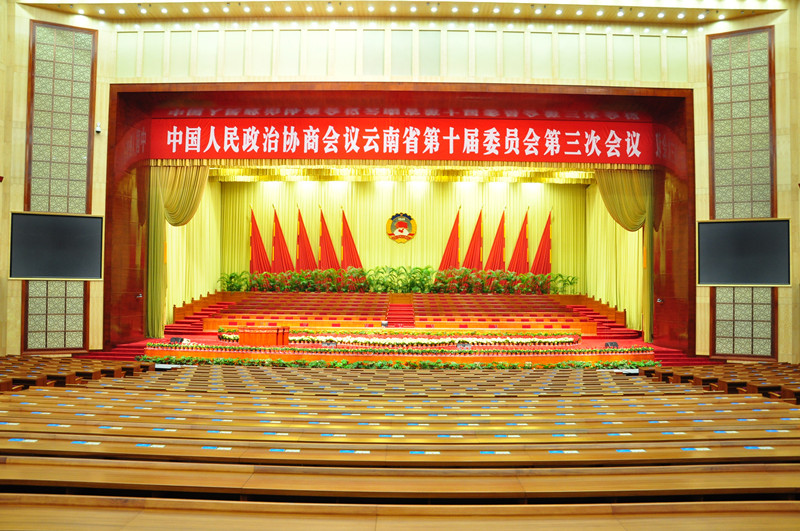
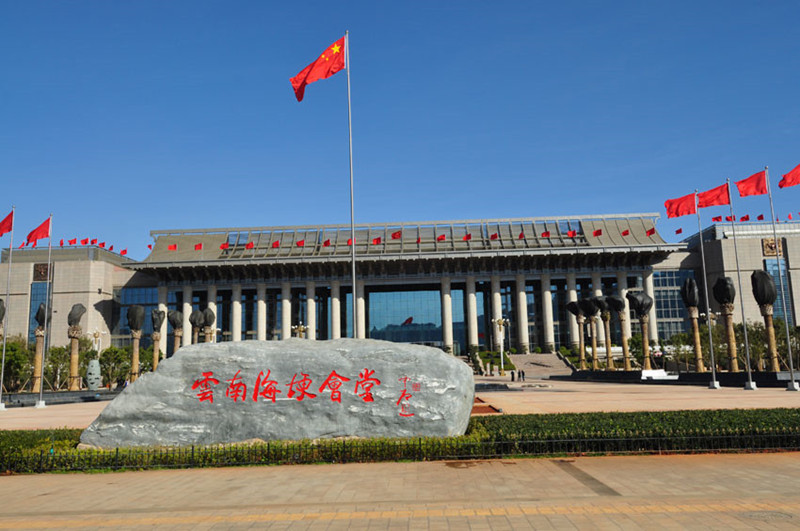
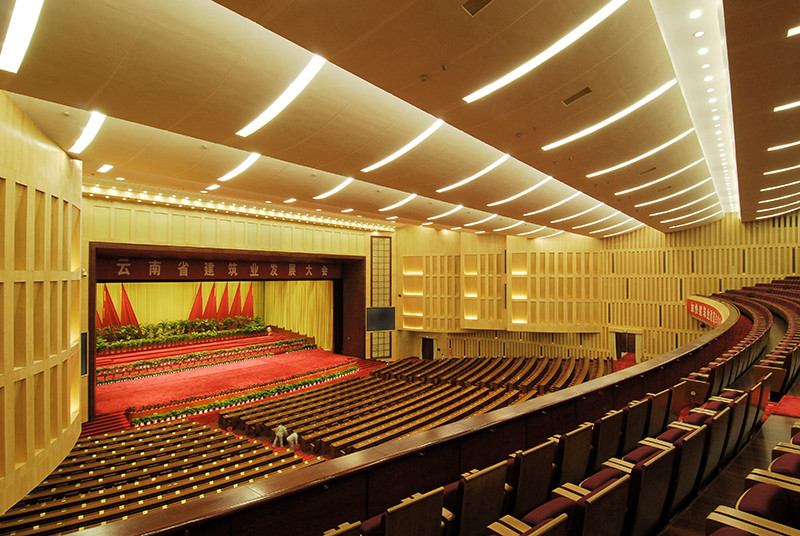
Overview of the Theater
The Yunnan Arts Theater (云南艺术剧院), as the only key theater in the province, has been responsible for artistic exchanges between Yunnan Province and domestic as well as international venues since the 1950s. Its stage showcases brilliant performances from artists around the world, where majestic music and graceful dance flourish. As a window for external communication, the Yunnan Arts Theater has presented numerous ethnic-themed song and dance performances to countries in Southeast Asia, as well as regions such as Hong Kong, Taiwan, and Japan.
Notably, the large-scale original ecological song and dance collection “Yunnan Impressions” (云南映象), produced by Yunnan Yang Liping Cultural Communication Co., Ltd., was performed at the Yunnan Arts Theater. In December 2019, the theater officially began self-management, engaging in leasing and performance cooperation with the community.
Transportation Information
To reach the Yunnan Arts Theater, you can take the following bus routes: 5, 10, 26, 66, 81, 82, 84, 98, 116, 124, and 207.
Honors Received
In February 2023, the Yunnan Arts Theater was selected for the “Seventh Batch of China’s 20th Century Architectural Heritage” project.
Unit Name: Yunnan Arts Theater (云南艺术剧院)
Supervisory Department: Yunnan Provincial Department of Culture and Tourism (云南省文化和旅游厅)
Main Responsibilities:
- Responsible for the creation and performance of flower lantern opera, and the promotion and popularization of flower lantern art, along with the protection and inheritance of Yunnan’s flower lantern intangible cultural heritage.
- Protect, inherit, and develop Yunnan’s ethnic music and vocal arts.
- Carry out major thematic creative performances.
Institutional Structure: The theater comprises six departments: General Office, Performing Arts Center, Ethnic Orchestra, Stage Art Center, Creation Center, and Intangible Cultural Heritage Center.
Office Location: No. 130, Dongfeng West Road, Kunming City (昆明市东风西路130号).
Office Hours: 8:30 AM – 6:00 PM (Monday to Friday, excluding legal holidays).
Contact Information: 0871-63612286, 0871-63625614.
Main Responsible Person: Huang Shaocheng (黄绍成).
How to Get There
The Yunnan Arts Theater is located at 81 Dongfeng West Road, Kunming City (昆明市东风西路81号). The most convenient way to get there is by taking one of the bus routes mentioned above. Alternatively, taxis and ride-sharing services are widely available in Kunming.
Travel Tips
- Plan Ahead: Check the performance schedule in advance and consider booking tickets online to ensure availability.
- Arrive Early: Arriving early allows you to explore the theater and its surroundings, and ensures you find your seat comfortably before the show starts.
- Local Cuisine: Try local Yunnan dishes at nearby restaurants to enhance your cultural experience.
- Respect Cultural Norms: Be mindful of local customs and etiquette, especially during performances.
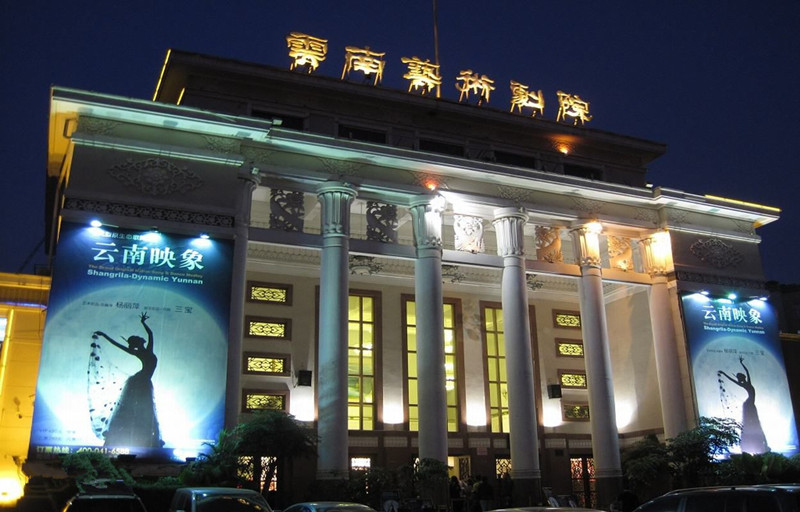
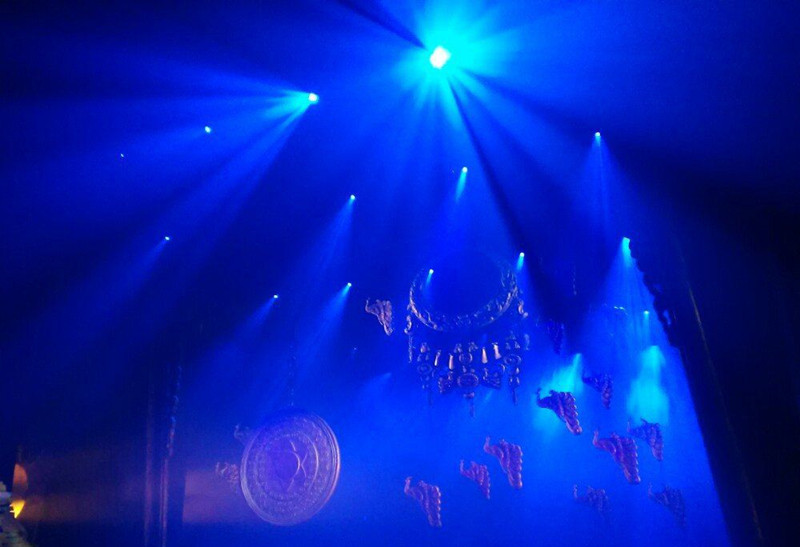
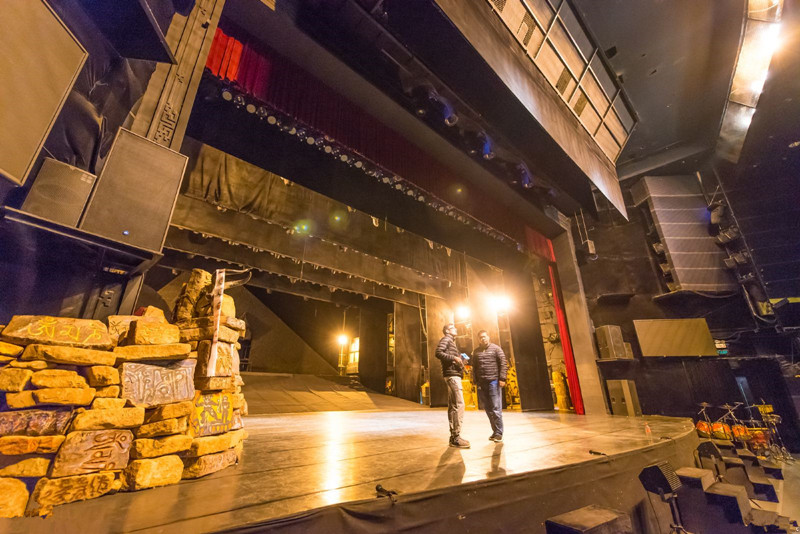
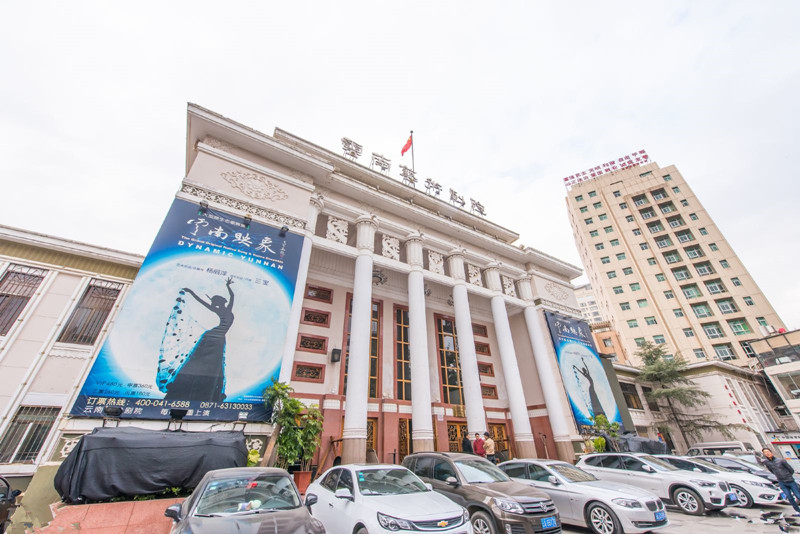
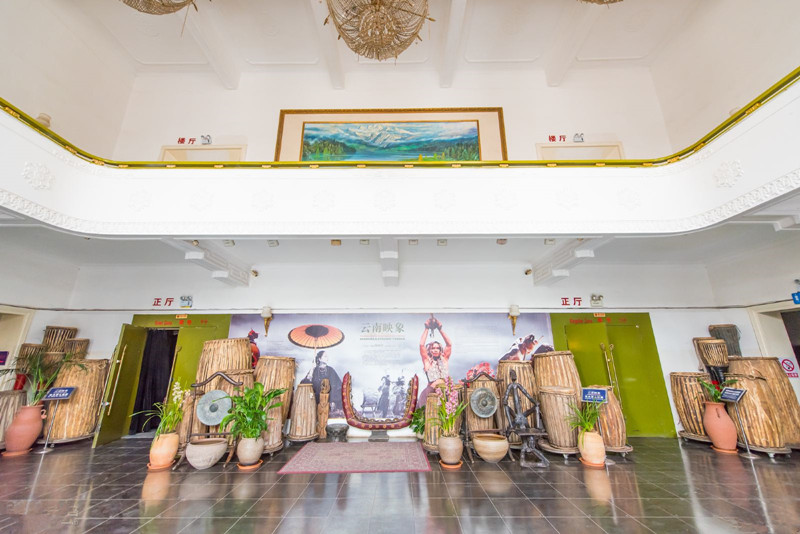
Introduction
The Hani Rice Terraces, situated in the southern part of the Ailao Mountains in Yuanyang County (元阳县), Honghe Prefecture (红河州), are a remarkable achievement of the Hani ethnic group (哈尼族). These terraces, cultivated over generations, represent a unique agricultural civilization shaped by the community’s ingenuity in harnessing the region’s distinctive geographical and climatic conditions.
The terraces are characterized by their stunning visual variations, adapting to the local topography. On gentler slopes, larger fields are cultivated, while steeper areas feature smaller plots. The Hani people’s resourcefulness allows them to even cultivate narrow stone crevices, leading to a diverse range of terrace sizes—from several acres to small patches the size of a hand basket. In total, there are thousands of acres across the region, often covering vast expanses of land.
The Honghe Hani Rice Terraces are primarily found in Yuanyang, as well as in Honghe, Jinping, and Luxi counties, spanning an impressive total area of around 1 million mu (approximately 165,000 acres). Within Yuanyang County alone, there are about 170,000 mu (approximately 28,000 acres) of terraces. This spectacular landscape has been meticulously “sculpted” by the Hani people for over 1,300 years, resulting in breathtaking vistas that draw visitors from around the world.
In recognition of its cultural and historical significance, the Honghe Hani Rice Terraces were inscribed as a UNESCO World Heritage Site on June 22, 2013, becoming the 45th World Heritage Site in China.
Area Overview
Major Scenic Areas
The Hani Rice Terraces are divided into three main scenic areas:
- Bada Scenic Area (坝达景区): This area includes over 14,000 acres of terraced fields, featuring notable locations such as Qinkou (箐口), Quanfuzhuang (全福庄), Malizhai (麻栗寨), and Zhulu (主鲁).
- Tiger Mouth Scenic Area (老虎嘴景区): Covering nearly 6,000 acres, this area includes Mengpin (勐品), Dongpu (硐浦), Amengkong (阿勐控), and Baoshan Zhai (保山寨).
- Duoyishu Scenic Area (多依树景区): This scenic area boasts tens of thousands of acres of terraced fields, including sites like Duoyishu (多依树), Aichun (爱春), and Dazhazhe (大瓦遮).
Additionally, there are other significant terraced locations in Yuanyang, including:
- Xiaopingzi Terraces (小坪子梯田) in Daping Township (大坪乡)
- Nikupu Terraces (尼枯浦梯田) and Laocaozhai Terraces (老曹寨梯田) in Fengchunling Township (逢春岭乡)
- Shibeizhai Terraces (石碑寨梯田) and Dalaki Terraces (大拉卡梯田) in Xinxijie Township (小新街乡)
These terraces vary greatly in shape and size, and many are less frequented by tourists due to their remote locations and challenging access.
Basic Information
Best Viewing Period
- Optimal Time: The best time to view the terraces is from December after the fields are flooded until April of the following year. This period offers spectacular reflections and vibrant colors in the water-filled terraces.
Key Scenic Spots
- Duoyishu (多依树): Best known for its stunning sunrises, where the early morning light dances on the terraces.
- Tiger Mouth (老虎嘴): Offers breathtaking sunsets; it is crucial to time your visit correctly for the best views.
- Qinkou (箐口): Renowned for its ethereal clouds, giving the feeling of walking among the heavens.
- Bada (坝达): Ideal for witnessing both sunset and the sea of clouds, with changing colors that enhance the beauty of the landscape.
Travel Tips
- Accommodation: Arrange your stay in advance, as distances between scenic spots can exceed 10 kilometers, and travel times can be significant.
- Transportation: Local transport between scenic spots is available for around 80 yuan. However, hiring a vehicle for larger groups can be more convenient.
- Timing: Ensure you plan your visits to the scenic spots based on the time of day—sunrise at Duoyishu and sunset at Tiger Mouth are particularly popular.
Accommodation Recommendations
Avoid staying in Yuanyang New Town (南沙镇), which is at a lower elevation, or Yuanyang Old Town (新街镇), which is further uphill. Staying in Duoyishu is highly recommended for easy access to sunrise views.
- Xiao Mago’s Inn (小马哥的客栈): Offers double rooms starting from 80 yuan per night, providing comfortable and convenient lodging.
- Duoyishu Youth Hostel (多依树青旅): A newly built hostel highly recommended by travelers. Prices start at 110 yuan for double rooms and 30 yuan for dormitory beds. The hostel’s early departure for sunrise views makes it a perfect choice for photographers.
Suggested Itinerary
Day Plan
- Recommended Stay: It is advisable to stay in Duoyishu for optimal access to the best viewpoints. Consider hiring a vehicle for less than 300 yuan per day.
Sample Itinerary:
- Early Morning: Sunrise at Duoyishu.
- Late Morning: Visit Bada for the sea of clouds.
- Afternoon: Explore Qinkou for additional cloud views.
- Evening: Sunset at Tiger Mouth.
Travel Considerations
- From Duoyishu to Bada, you can catch a ride for about 10 yuan.
- To enjoy the cloud views at Qinkou, find a viewpoint on the way rather than from within the village.
Additional Information
Temperature and Weather
- Weather Conditions: Be aware that weather forecasts often reflect conditions in Nansha. The mountain areas can be significantly colder, especially at sunrise. Dress warmly, preferably in layers.
Cloud Seas
- Appearance of Cloud Seas: These spectacular cloud formations typically appear the day after rain, adding to the beauty of the landscape.
How to Get There
By Bus
- Public Transport: Most buses arrive at Nansha Town, where travelers must transfer to reach Xinjie Town and Duoyishu. Direct buses are available from Xinjie Town to Jianshui and Kunming, with the latest departure to Jianshui at 4:30 PM. Long-distance buses from Jianshui to Yuanyang operate at 11:30 AM, taking highways and secondary roads.
By Car
- Driving Directions: If driving from Kunming, take the highway to Yuxi, then to Yuanjiang. This segment is mostly highway. After Yuanjiang, the route to Honghe consists of secondary roads, making for a smoother drive. From Yuanjiang to Yuanyang, the journey takes less than three hours.
Overview
Laoyeshan Mountain (老爷山) is recognized as one of the Ten Steepest Mountains in Kunming, located between Yiliang County (宜良县) and Guandu District (官渡区) of Kunming. The mountain features a verdant landscape on its eastern side, while the upper parts are extremely steep. From the summit, visitors can enjoy breathtaking views of Yangzong Lake (阳宗海) and the Yiliang Basin (宜良盆地). A local temple fair is held on the 15th day of the sixth lunar month, attracting villagers from surrounding communities.
- Highest Altitude: 2,730 meters
- Duration: One day
- Trekking Mileage: 9 km
- Route: Kunming-Muxi Village (昆明-木希村, Tangchi Town, Yiliang County) and Kunming-Adi Village (昆明-阿底村, Dababqiao Town, Guandu District)
Mountain Details
Laoyeshan, originally named Wuna Mountain (乌纳山), stands as the highest peak in the region with an altitude of 2,730 meters. It is located north of Tangchi Town, where Yangzong Lake can be found.
- Geographical Location: Yiliang County (宜良县) and Guandu District (官渡区), Kunming, Yunnan Province (云南省昆明市)
- Area: 66 km²
- Mountain Characteristics:
- Laoyeshan has a northeast-southwest orientation, stretching approximately 22 km in length and 3 km in width. The area spans 66 square kilometers. The mountain comprises ancient Paleozoic Permian basalt and limestone. With an average altitude above 2,400 meters, there are 19 peaks surrounding the main summit. The elevation difference in the southeast is about 930 to 950 meters, classifying it as a dissected mid-mountain landscape.
Climbing Route
The climbing route begins from Muxi Village and leads to Xihua Temple (西华寺). The left path is a stair-like ascent, while the right path descends via a small road alongside Xihua Temple, featuring mountain springs and caves. After exiting the forest, both paths converge. The latter section involves rocky trails with a gradual incline. At the summit, there is a stone tablet, and on either side of the platform are two peaks: to the left is Laoyeshan, featuring the Cihang Pudu Temple (慈航普度庙) and a monument established by the Yiliang County Mountain Climbing and Camping Association. To the right lies Laoyu Mountain (老禺山), with a temple and several merit tablets. The height difference between the two peaks is minimal.
The round trip generally takes about 3 to 4 hours.
Local Cuisine and Culture
- Temple Fair: Celebrated on the 13th day of the sixth lunar month, this local temple fair, organized by villagers, is also known as the Earth Lord Temple Fair (土主庙会).
- Intangible Cultural Heritage: Yiliang Roast Duck (宜良烤鸭) and Tangchi Pickles (汤池酱菜).
Time, Cost, and Considerations
- From Chenggong (呈贡) to Tangchi (汤池): approximately 45 kilometers, 2 hours, cost around 11 yuan per person.
- From Tangchi to Muxi Village: northward for 7 kilometers, using a motorcycle taxi or van for about 2 yuan per person.
Additional Information
- Approximately 6 kilometers north of Yangzong Lake lies Laoyeshan, which is the highest peak at 2,730 meters, while the western slopes comprise the Wuna Mountain range.
- The area has a rich history of over 800 years of local worship, with the Earth Lord deity believed to be embodied by a giant stone resembling a horse’s head, bestowing blessings upon the faithful.
How to Get There
To reach Laoyeshan, take public transportation or drive from Kunming to Tangchi Town. From there, continue to Muxi Village by motorcycle taxi or van.
Travel Tips
- Wear sturdy shoes suitable for hiking, as the trails can be steep and rocky.
- Plan your visit for early morning to enjoy cooler temperatures and fewer crowds.
- Bring snacks and water, as amenities may be limited in the mountainous area.
- Respect local customs, especially during the temple fair, to fully experience the cultural heritage of the region.
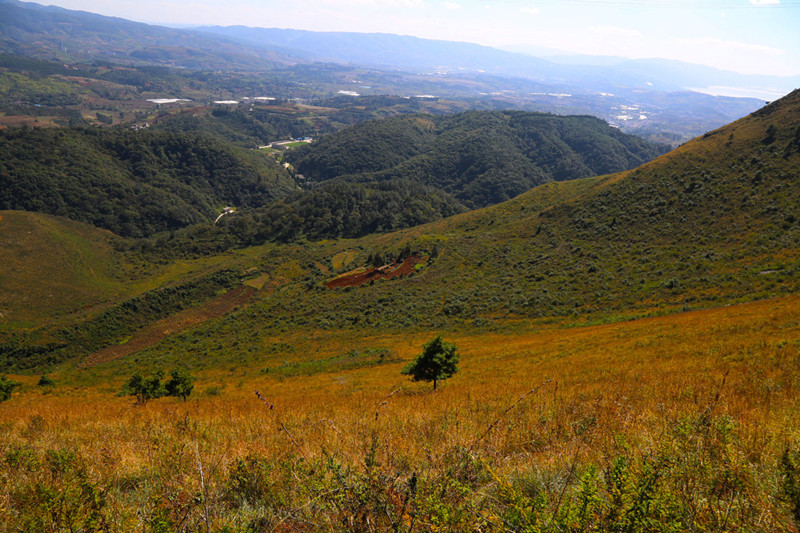
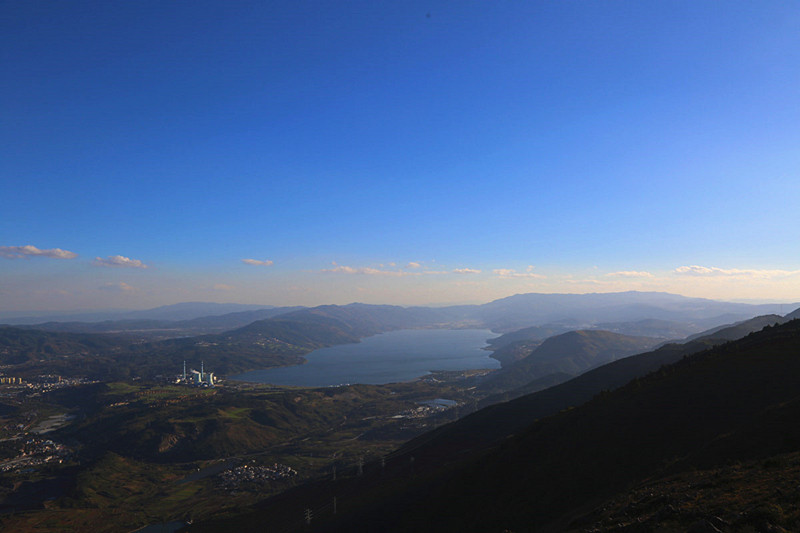
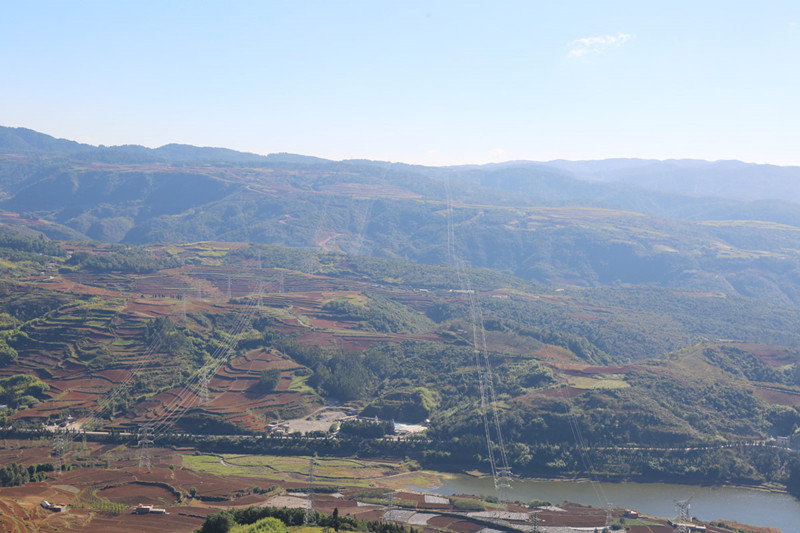
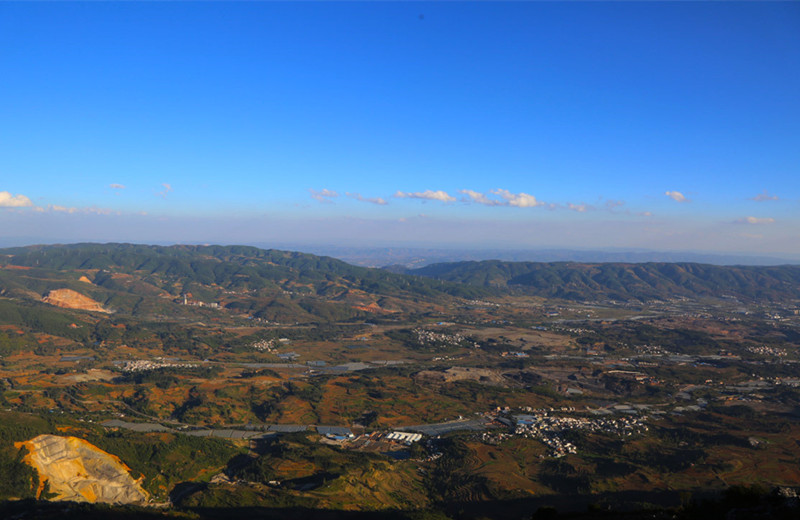
Chinese Name:石林奇风洞
English Name: Qifeng Cave in The Stone Forest, Kunming
Qifeng Cave is 5 kilometers away in the northwest of The Stone Forest,in the middle of Beida village Shuitang village and madong village,steep cliffs and stone peaks are standing inside of it. The rocks out there all have their own characteristics,some of them are like the lighting torch of Hani People in their Torch festival ;a number of them are like clean lotus;some just look like cute little mushroom。A huge guard-like peak are standing right next to Qifeng Cave。There is cropland under the peak,A tiny cave makes the entry of Qifeng Cave。 Qifeng cave is the strangest one among other caves of Shilin,It’s not famous for strange-looking rocks,but noted for the rocks in there can breath just like human。so people refer it as the breathing cave.
Phenomenon
every rainy season,when the land gets humid and rivers starts to flow,The wind will blow into Qifeng Cave, and start to make noise like a tired bull。the wind is so strong, if you try to cover the caves with mud. It still breaths just fine by blowing the mud away。
When it starts to breath, a loud noise will come with it。 So loud, it will make you think there is a wave coming in your way.but when you start to wonder around where it comes from, you can’t find a thing. it’s like a prank that nature plays at you. If you put a burning woods or torch upon the cave, the flame could go up to 2~3 meters high.
Another wonder
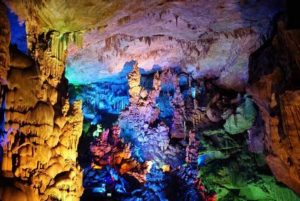
Hongxi Fountain is another marvelous scene in Qifeng Cave,Clean spring flows out the cave and infuses into a deep hole,A thunderous sound will occur when the hole gets full. After 2 or 3 minutes everything returns to normal. And then the spring starts to flows again, this wonder repeats every 30-40 minutes
Coaction
Qifeng Cave, Hongxi Fountain and the underground river are such great group, none of them will be existed without another two. For example, in the dry season Qifeng Cave will suffocate due to the lack of water in the underground river. It can’t breath either, if there is too much water in the underground river.。So it makes the best time of visiting Qifeng Cave from June to October 。
Explanation
The landform of Qifeng Cave is not usual。In the eastern side of Qifeng Cave,there is a gully made by years of erosion.When the rain or water flows into this gully, they will be going into the underground river as well. Because of lack of room to store those water, and with the effect of wind. Qifeng Cave became possible. You may call it siphon effect of nature.
Chinese Name: 石林芝云洞
Zhiyun Cave scenery is close to The Stone Forest scenery,6 kilometers away from major&minor stone forest scenery.On the east side of Shi’An freeway. There is mountain constructed by limestone,that’s where Zhiyun Cave scenery is。Zhiyun Cave Scenery is made of Zhiyun Cave、Minor Zhiyun Cave(叠云岩)、Jibailong Cave、Zhu’er Cave、Dagang Cave.It’s the best place to explore karst landform。Till now you are allowed visit only Zhiyun Cave, Minor Zhiyun Cave and the Jibailong Cave.Other scenery are still under construction.
The cave is 400-meter-long,3 to 15 -meter wide and 5 to 30-meter tall.The entire cave looks like the letter “Y” The Zhiyuan Cave and Minor Zhiyun Cave gets connected by a little gate.Inside the cave, we can find the top one scene in Shilin scenery,named “石硐仙踪”。 At the start of the cave to the very end. There are morn than 20 scenes you can visit.
Zhiyun Cave
Zhiyun Cave was decorated 400 years ago, earliest among others.The rocks inside cave are in shape of Lingzhi and colorful cloud, So people name it Zhiyun Cave。The stele was built by Wangliang in Ming Dynasty.The stele is 1.6-meter tall,0.6 meter wide and 0.3 meter thick, made by jade rocks. In 1986 it was named “the protected heritage of county”. With the latest construction, Zhiyuan Cave is installed with lights and other facility to ensure the tourists visit the cave safely and nicely.
Jibailong Cave is under the Jibailong mountain of Tianshanqiao village,4 kilometers away from major&minor stone forest, 2 kilometers away from Zhiyuan Cave。450-meter-long,10—20 meter-high,5—10 meter-wide. All the scene and rocks inside the cave are well protected by the local government.You may need at least one hour to visit this Cave.
Minor Zhiyun Cave(叠云岩)
Right cross the Zhiyuan Cave, we can find another fabulous scenery,called Minor Zhiyun Cave,it goes public in 1998。This cave is 200-meter long ,30-meter high and 8-meter wide。What’s so special about Minor Zhiyun Cave is its rocks. they present themselves in many ways for tourists.
Ticket selling is 10 meters cross the gate of cave, you need at least 30 minutes to go through the cave.
All three caves are latest renewed, safety and comfort can be ensued. Snacks and souvenir are all available inside the cave.
Temperature is all good throughout the year, you need at least 4 hours to finish viewing 3 caves
Strongly suggests to plan on a trip for those caves first, then you can go to major&minor stone forest to avoid the crowds。High heels are not suggested inside the caves
Hani Rice Terraces List in Honghe County, Honghe
Chinese Name:红河县哈尼梯田大全 English Name:Rice Terraces in Honghe County, Honghe Keywords: Hani Rice Terraces Location: In the south of Ailao Mountain of Honghe Prefecture Admission Fee: ¥ Opening Hours: All Day Long...
Rice Terraces List in Lvchun County, Honghe
Chinese Name:红河绿春县哈尼梯田 English Name:Rice Terraces in Lvchun County, Honghe Keywords: Hani Rice Terraces Location: In the south of Ailao Mountain of Honghe Prefecture Admission Fee: ¥ Opening Hours: All Day Long...
Hani Rice Terraces List in Jinping County, Honghe
Chinese Name:红河金平县哈尼梯田 English Name:Hani Rice Terraces in Jinping County, Honghe Keywords: Hani Rice Terraces Location: In the south of Ailao Mountain of Honghe Prefecture Admission Fee: ¥ Opening Hours: All Day Long Overview...
The Ancient Tea Horse Road from Baisha Ancient Town to Wenhai Lake
Chinese Name:丽江茶马古道:白沙古镇-玉水寨-玉龙水库-文海 English Name: The Ancient Tea Horse Road from Baisha Ancient Town to Wenhai Lake(Baisha Ancient Town-Yushuizhai-Yulong Reservior-Wenhai Lake) The Ancient Tea Horse Road, a historic trade route...
Lijiang Basin
Lijiang Basin Millions of years ago, a tremendous geological force pushed the Indian Plate northward, colliding with the Eurasian Plate. The two plates, being of comparable density, resulted in...
Baisha Basin in Lijiang
Overview Baisha Bazi (白沙坝子) is a picturesque village located in Lijiang, Yunnan Province (云南省丽江市). It is known for its rich cultural heritage, traditional Naxi architecture, and stunning natural landscapes....
Yunnan Haigeng Auditorium
Overview Kunming Haigeng Hall (昆明海埂会堂) is a prestigious venue under the management of the Yunnan Haigeng Conference Center Management Bureau. Situated in the scenic area of Dianchi (滇池), it...
Yunnan Art Theater
Overview of the Theater The Yunnan Arts Theater (云南艺术剧院), as the only key theater in the province, has been responsible for artistic exchanges between Yunnan Province and domestic as...
Hani Rice Terraces List in Yuanyang County, Honghe
Introduction The Hani Rice Terraces, situated in the southern part of the Ailao Mountains in Yuanyang County (元阳县), Honghe Prefecture (红河州), are a remarkable achievement of the Hani ethnic...
Laoyeshan Mountain in Yiliang County, Kunming
Overview Laoyeshan Mountain (老爷山) is recognized as one of the Ten Steepest Mountains in Kunming, located between Yiliang County (宜良县) and Guandu District (官渡区) of Kunming. The mountain features...
Qifeng Cave in The Stone Forest, Kunming
Chinese Name:石林奇风洞 English Name: Qifeng Cave in The Stone Forest, Kunming Qifeng Cave is 5 kilometers away in the northwest of The Stone Forest,in the middle of Beida village Shuitang...
Zhiyun Cave in The Stone Forest, Kunming
Chinese Name: 石林芝云洞 Zhiyun Cave scenery is close to The Stone Forest scenery,6 kilometers away from major&minor stone forest scenery.On the east side of Shi’An freeway. There is mountain...


















